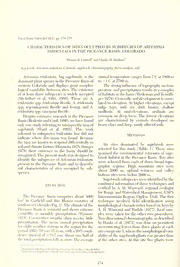
CHARACTERISTICS OF SITES OCCUPIED BY SUBSPECIES OF ARTEMISIA TRIDENTATA IN THE PICEANCE BASIN, COLORADO PDF
Preview CHARACTERISTICS OF SITES OCCUPIED BY SUBSPECIES OF ARTEMISIA TRIDENTATA IN THE PICEANCE BASIN, COLORADO
GreatBasinNatiinJist52(2),pp. 174-178 CHARACTERISTICS OF SITES OCCUPIED BY SUBSPECIES OFARTEMISIA TRIDENTATA IN THE PICEANCE BASIN, COLORADO Thomas R.Cottrell andChiules D. Bonham" Kit/words: Artemisiatridentata. Colorado,sagehnisli,clirointifoij^raplu/,factoranalysis,sod. Artemisia tridentata, big sagebiiish, is the annual temperature ranges from 7 C at 1800 m dominantplantspeciesinthePiceance Basinof to -1 C at2700 m. western Colorado and displays great morpho- The stronginfluence oftopographyon tem- logical variabilitv between sites. The existence peratiu'e and precipitation results in acomplex ofat least three subspecies is widely accepted ofhabitats inthebasin (TiedemanandTerwilli- (McArthur et al. 1981, 1988). These are A. ger 1978). Generally, soildevelopmentiscorre- tridentata spp. tridentata Beetle, A. tridentata lated to elevation. At higher elevations, except spp. ivi/oming^ensi.s Beetle and Young, and A. ridge tops, soils are dark brown, shallow tridentata spp. vaseyana Beetle. mollisols. At mid-elevations, aridisols are Despite extensive research in the Piceance common on deep loess. The lowest elevations Basin (RedenteandCook 1986),wehavefound are characterized by entisols developed on only one study referringto intraspecific taxa of heavyclays anddeep, sandyalluvial soils. sagebrush (Ward et al. 1985). This work referred to subspecies tridentata but did not Methods indicate where this taxon was found. Because the taxa are known to respond differentiiilly to Six sites dominated by sagebrush were soilandclimatefactors(Hironoka 1978,Sturges 1978) their existence in the basin should be selected for this study (Table 1). These sites spanned the environmental extremes of sage- recognized. The present studywas designed to brush habitat in the Piceance Basin. Two sites identify the subspecies o{Artetnisia tridentata were selected from each ofthree broad topo- present in the Piceance Basin and to describe graphic regions. High mounttiin sites were soil characteristics of sites occupied by sub- about 2000 ni; upland terraces and valley species. bottom siteswere below2000 m. Sagebrushsubspecieswereidentifiedbvthe Study Site combined information ofthree techniques and verified by A. H. Winward, regional ecologist for Range andWatershed Management, USFS The Piceance Basin comprises about 3()()() Intermountain Region, Ogden, Utah. The first km" in Garfield and Rio Blanco counties of technique involved field identification using northwest Colorado (Fig. 1). ThecUmateofthe moqihological characteristics based on keys by Piceance Basin is semiarid and shows extreme A. H. Winward and Tisdale (1977). Leafsam- variability in monthlv precipitation (Wymore ples were taken for the other two procedin-es. 1974). Consecutive months often receive little Two-dimensionalchromatography,asdescribed precipitation. The mean annual precipitation by Hanks et al. (1973), was done on persistent for eight weather stations in the region for the overwintering leaves from three plants at each period 1951-70was 35.3cm,with a95% confi- siteexceptsite5,wherethemoqihologiciilvari- dence intei-val of ±18.7 cm. About one-halfof abilit)'ofthe sagebnish plants was greaterthan thetotalprecipitation fallsassnow.Theaverage at the other sites. At this site five plants were ^DepartmentofBiology,ColoradoStateUniversity,FortC^ollins.Colorado80523. RangeScienceDepartment,(ColoradoStateUniversity,FortCollins,Colorado80.52,3. 174 1992] Notes 175 WYOMING m. PICEANCE BASIN OLORADO C ''830 NEW MEXICO 2130- 2430- Meeker e^^ P'il 40°N / PICEANCE BASIN COLORADO SCALE IN MILES SCALE IN KILOMETERS CONTOUR INTERVAL 300m Fig. 1. TheshulviireaofthedistribuHcMi,AAnemisia trklcutata subspeciesi„ northuestColorado. tested by chromatography. Results were com- matelv ISotherplants inthestucK-sites Leaves paredwith representative chromatograms. The were crushed In hand and placed in glass con- hirdprocedurewas a leafextract in uater. This tainersforfourhours.Thesewereviewedunder Ubiyttcerhrmoemtahtoodgrwaapshpyerafnodrmoendaontoatlallploafntaspptreosxtie-d dleosncgr-iwpatvioensulbtyraSvtioelveetnsliagnhdt MacnAdrtchoumrpa(r19e7d4)to 176 Great Basin Naturalist [Volume52 Tabi.K1.Location,elevation,;uidsagebnislisubspeciesofstutlysites.VAS—ssp.id.sci/ana:TRI —ssp.tridoitata:WTO = ssp.wuoimngensis. Selectedsoilcharacteristicsarelistedfor()-L5cmand 16^30cm soilsamplesforeachsite. L()cation 1992] Notes 177 3s LJ < 1.5 Ld u O < 0.5 - Q < - -0.5 cOt: uI— -1 - < -1.5 -1.5 178 Great Basin Naturalist [Volume 52 consequently, different life history'strategies in HiRONAKA. M. 1978. Basic svnecological relationships of the subspecies (Bonham et al. 1991). TthheeCsoalguembbniisahReicvoesrysstaegme:brausshytmyppoes.iuPma.gesUt2a7h-.3St2atine Soils at sites with ssp. vaseyana are distin- University, LogiUi. guished from the other sites by factor 2 ofthe McARTHUR, E.D.,C. L. Pope,andD.C.Freeman 1981. factoranalysis. Thisaxis represents bothan ele- ChromosomalstudiesofsubgenusTridentataeofArte- vational and soil pH gradient (Table 1, Fig. 2). moifsBiao:taenvyid6e8:nc5e89f-o6r0a5u.topoKploidv. AmericanJournal Siteswith ssp. vaseyana were at ahighereleva- McArthur, E. D., B. L. Welch, andS. C. Sanderson. tion, and soils were lower in pH and CaCO^ 1988. Naturdandartificialhybridizationbetweenbig values. Thetextures atthese sites didnot differ sagebnish{Artemisiatridentata)subspecies.Journalof substantiiillvfrom theothersites. Heredit)'79:268-276. Noprevious studyin the areahas identified Redefnutnect,ioEn.alF.,cahnadngCe.sW.inCoeaorkl,yesducsce1s9s8i6o.naSltrsutcatguersaloafnda these taxa or characterized their habitats. The semiaridecosystem. Progress Reportto U.S. Depju't- great differences in habitat preference among mentofEnergy. DepiutmentofRangeScience,Colo- these subspecies suggest this is a major over- Shumraard,oSMt.atLe.,UaninvdersiEt.y,AFnodretrCsololnins.196876.ppG.radientanal- J. sight. ysisofvegetationdominatedbytwosubspeciesofbig sagebnish. Journal of Range Miuiagement 39: 156- 159. Acknowledgments Stevens, R., iuid E. D. McArthur 1974. A simple field technique for identification ofsome sagebnish taxa. JournalofRange Management27:.325-.326. The research was supported jointly by the Sturc:es. D. L. 1978. Hydrologic relations ofsagebrush U.S. DepartmentofEnergy, Contract No. DE- lands. Pages 86-100 in The sagebnish ecosystem: a AS02-76EV04018toColoradoStateUniversit)- symposium. UtahState Universitv',Logan.251pp. andthe Agricultural E.xjoeriment Station, Colo- TiEDEMAN. J. A., and C. Terwilliger. Jr 1978. A phy- toedaphic classification ofthe Piceance Basin. Colo- rado State University, Project 660(4242). radoState University, Department ofRange Science, ScienceSWeries31.265pp. Literature Cited Ward. R. T, L. Slauson, and C. W. Weldon 1985. Responseofshnibecotvpes to miningwaste material in soil profiles and competitive interactionsofwoodv' Affifi. a. a.,andClark. V. 1984. Computer-aidedmulti- species under experimental and naturiJ conditions. variate analy.sis. Lifetime Learning Publications, Bel- Pages87-94in E. ¥.Redente,C.W.Cook,J. M. Stark, mont,California.458pp. andC.L.Simmons,eds.,Semiaridecosvstemde\eIop- Bakkeenrc,esJ.bRe.,twaenednCb,asMi.n MancdKWeylolmi1n9g83.bigHasbaigteabtrduisfbferi-n tmieonn.tParsogarfeusnsctRieopnorotfrtoesUo.uSr.ceDeprpoacretsmseinngtaonfdEnaelrlgo\c-a.- contiguous populations. Journal of Range Manage- ColoradoState University, DepartmentofRange Sci- ment36:450-454. ence,FortCollins. BoNiiAM. C. D., T. R. CoTTHELL. and E. Mitchell. Winward, A. H., and E. W. Tisdale 1977. Titxonomvof 1991.InferencesforlifehistorystratJe.giesofArtemisia theArtemisiatridentata complexin Idiilio. Uni\ersit\' tridentatasubspecies.JournalofVegetationScience2: ofIdiilio, Forest,WildlifeandRangeExperimentSta- 339-;344. tion Bulletin No. 19. 15pp. GooDRiCM, S., E. D. McArthur, and A. H, Winward WvMORE, I. F. 1974. Estimated average annualwaterbal- 1985.AnewcombinationandanewvarietyoiArtemi- anceforPiceanceandYellowCreekwatersheds.En\a- siatridentata. Great Basin Naturalist45: 99-104. ronmentiJ Resources Center, Colorado State Hanks, D. L., E. D. McArthuk. R. Steven.s, and A. R University, Fort Collins. Technical Report Series No. PiAJMMER. 1973.Chromatographiccharacteri.sticsand 2. 60pp. phylogeiietic relationships of Artemisia section Tridentatae. USDA Forest Service Research Paper Received20November1991 INT-141.24pp. Accepted4May 1992
